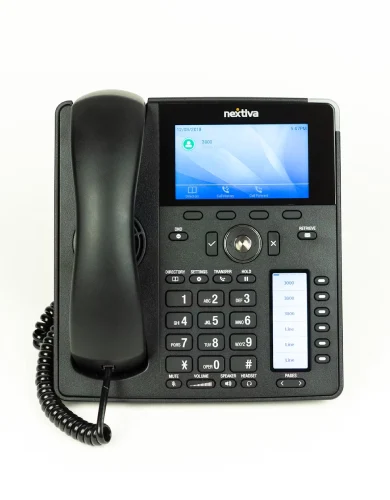Network monitoring tools for businesses
Network monitoring tools are crucial for maintaining a high-quality internet connection such as leased line broadband.
Monitoring tools help detect website outages that might disrupt e-commerce, flags suspicious traffic that could indicate security risks, and even diagnoses a sudden drop in the quality of your guest WiFi.
This guide explores network monitoring, explaining how it benefits businesses and how to choose the right tools for your company. We cover:
- What is network monitoring?
- Types of network monitoring tools
- Pros and cons
- Popular network monitoring software for businesses
- Choosing the right one
- Implementation and best practices
What is network monitoring?
Network monitoring continuously tracks a network’s health, performance, and security using specialised software. It is part of network operations handled by internal IT team or managed IT services.
The primary goal is to ensure that all local area network components, including servers, business broadband routers, network switches, and devices, operate efficiently and securely.
Key features of network monitoring
Key features of network monitoring tools include:
- Real-time tracking: Provides up-to-the-minute insights into data flow, bandwidth usage, and device performance, ensuring continuous visibility into your network’s status.
- Instant alerts: Real-time alerts for outages, slowdowns, or security breaches allow administrators to respond quickly and minimise downtime.
- Performance metrics: Tracks bandwidth usage, packet loss, business broadband speed and latency. Network monitoring helps identify bottlenecks and improve overall network efficiency.
- Traffic analysis: Examines data flow to spot high-traffic patterns or suspicious activity. It covers essential cybersecurity and performance monitoring.
Types of network monitoring tools
Network monitoring tools come in various forms, each designed to address different aspects of network oversight.
Some focus on overall network performance, while others target specific hardware, software, or traffic-related metrics. Network monitoring software solutions provide a unique combination of these tools to target a specific market niche.
To help illustrate the range of network monitoring tools, here is a table with the different types of tools with examples of providers that offer them:
| Type of network monitoring tool | Description | Example product |
|---|---|---|
| SNMP (Simple Network Management Protocol) | Monitors network devices (routers, switches) using SNMP to gather real-time performance data. Widely available in most network monitoring systems. | PRTG Network Monitor |
| NetFlow and Bandwidth monitoring | Tracks and analyses network traffic flow, providing insights into bandwidth usage and potential congestion. Ideal for large networks needing traffic visibility. | SolarWinds NetFlow Traffic Analyzer |
| Uptime monitoring | Continuously checks device status and alerts administrators if a device goes offline, ensuring network availability. | Pingdom |
| Application performance monitoring (APM) | Monitors the performance of critical applications, alerting on slowdowns or failures to maintain smooth operations. | Datadog APM |
| Traffic analysis | Uses methods like packet sniffing to analyse real-time data flows and optimise network performance by identifying congestion points. | Wireshark |
| Wireless network monitoring | Monitors wireless networks to ensure optimal performance of WiFi access points across a mesh network. | Ekahau |
| Cloud-based network monitoring | Monitors cloud or hybrid infrastructure, tracking performance of cloud applications and services. Essential for businesses using cloud platforms. | Site24x7 |
| Network traffic shaping tools | Prioritises critical traffic (e.g., business VoIP systems) to prevent bandwidth throttling and overuse and ensure important services maintain high performance. | ManageEngine NetFlow Analyzer |
Pros and cons of network monitoring for businesses
Network monitoring is a valuable tool for businesses of all sizes, providing essential insights into network performance and security.
However, its utility may vary depending on a business’s reliance on digital services or IT infrastructure. For businesses with minimal network requirements, implementing monitoring tools may seem unnecessary or lead to an overload of non-critical alerts if not properly managed.
As with any technology, network monitoring has benefits and challenges. Understanding these can help businesses decide whether the investment is right for them. Let’s explore the key advantages and potential drawbacks of network monitoring tools:
Benefits of network monitoring for businesses
- Minimises downtime: Real-time alerts instantly notify businesses of network issues, allowing them to resolve problems quickly, reducing costly downtime and ensuring operational continuity.
- Enhances security: Network monitoring tools help detect abnormal traffic patterns or unauthorised access, providing early warnings of potential cybersecurity threats and enhancing overall security.
- Improves performance: By tracking bandwidth usage and traffic flows, businesses can optimise network performance, reduce congestion, and ensure critical applications get the necessary resources.
- Reduces troubleshooting time: Automatic diagnostics help pinpoint the source of issues, reducing the time spent on troubleshooting and leading to faster resolution.
- Compliance support: Many industries, such as healthcare or finance, require businesses to meet strict data protection and network performance standards. Network monitoring tools assist by providing logs and reports for cybersecurity compliance.
Drawbacks of network monitoring for businesses
- Complexity: Implementing network monitoring tools can be complex and time-consuming, especially for businesses without dedicated IT staff. Proper configuration is critical to avoid unnecessary alerts and misinterpretations.
- Cost: High-quality network monitoring solutions, especially for small businesses broadband customers and startups, can be expensive. In addition to software costs, there may be ongoing fees for scaling or additional features.
- Alert overload: Network monitoring tools can generate too many alerts without proper configuration, overwhelming IT teams with notifications about minor issues or false positives.
- Requires ongoing management: To stay effective, monitoring tools need regular updates and fine-tuning, which can require ongoing attention from IT staff to adapt to network changes or new security threats.
Popular network monitoring software for businesses
Hundreds of network monitoring software are available, ranging from open-source solutions to enterprise-grade, commercial products.
It is common for comparison and review websites to list 30 or more solutions, differentiating them by paid, free, open-source and complex and simple products.
Instead of recompiling what has already been done, we give you the five most popular network monitoring solutions currently used by UK businesses:
Nagios
Nagios is a widely used open-source tool for real-time monitoring of network devices, servers, and applications. Its flexibility and extensive plugin support make it ideal for businesses needing customisable monitoring solutions.
SolarWinds Network Performance Monitor (NPM)
SolarWinds NPM is a leading commercial solution designed for large-scale environments. It provides detailed insights into network health with features like network mapping, automatic device discovery, and advanced traffic analysis, making it a top choice for complex networks.
Paessler PRTG Network Monitor
PRTG is an all-in-one monitoring tool that combines SNMP, bandwidth, and uptime monitoring. Its modular design allows businesses to only pay for the sensors they need, making it a scalable option for companies of all sizes.
Zabbix
Zabbix is an open-source, enterprise-level tool that provides real-time monitoring for servers and network devices. Known for its scalability, it can monitor thousands of devices and supports custom alerts and automated responses for proactive issue resolution.
ManageEngine OpManager
OpManager offers comprehensive network performance and fault monitoring. With features like network mapping, real-time alerts, and bandwidth tracking, it stands out for its ease of use and strong integration with other IT tools, making it ideal for hybrid network infrastructures.
Choosing the right business network monitoring software
Picking the right network monitoring software involves understanding what your business needs. Here are the main factors that will affect your choice:
Business Size
Small businesses benefit from simple, budget-friendly tools like Paessler PRTG and Nagios, while large companies benefit from comprehensive solutions for handling complex networks with multiple sites and devices, such as Zabbix.
Network complexity
More complex network setups, such as SD-WAN connectivity for multi-premise sites or 5G private networks for high-bandwidth IoT devices, demand advanced tools to monitor numerous devices, applications, and cloud services.
Budget
Do a cost-benefit analysis. Open-source tools are cheaper but may require more setup and won’t have the same level of support as commercial tools with advanced features and 24/7 assistance.
Integration
It’s important to consider how network monitoring integrates with other tools that manage your network or consume bandwidth to avoid performance issues. Examples of software that can integrate or, in some cases, cause conflicts include:
- Cybersecurity software: Network monitoring can complement firewalls or intrusion detection systems by providing additional insights into traffic patterns, but overlapping scans or traffic analysis can cause redundancy.
- Digital business phone lines: VoIP heavily relies on network bandwidth, and monitoring tools help ensure VoIP call quality by prioritising traffic. Inadequate integration or configuration could lead to poor call quality or dropped calls during high traffic. Find out more in our guide to managing VoIP in high traffic.
- Cloud-based services: Cloud applications such as UCaaS services can consume significant bandwidth, and traffic analysis can help measure any performance issues.
Implementing network monitoring in your business
Implementing network monitoring requires a few straightforward steps to ensure your system is appropriately set up and monitored effectively.
- Evaluate your network: Identify key devices, traffic, and potential points of failure. Remember to take into account VPNs, Zero Trust Network Access, network load balancing, and other atypical network protocols and devices.
- Choose the right software: Select based on your network’s size, complexity, and budget.
- Set up monitoring protocols: Define which metrics to track and set alert thresholds.
- Test and fine-tune: Ensure the system is catching critical issues without over-alerting.
- Train your team: Ensure staff can effectively use the tool for monitoring and troubleshooting.
This process may need adjustments based on the complexity of your solution, but it offers a general idea of the implementation.
Note: Business broadband providers and leased line providers don’t offer network monitoring tools, so you must obtain them from third-party providers.
Best practices for network monitoring
Finally, here are some pro tips for you to get the most out of your business network monitoring tools, especially if you are a small business with limited expertise:
- Set clear alert thresholds: Avoid overwhelming your team with unnecessary alerts by fine-tuning thresholds for critical issues only.
- Review and update regularly: As your network evolves, adjust what you monitor and ensure new devices or services are included.
- Document incidents: Keep detailed logs of issues and resolutions to improve processes and facilitate future troubleshooting and compliance.
- Automate when possible: Leverage automation to resolve minor issues and save time for more critical tasks. AI is your friend!
Network monitoring tools for businesses- FAQs
Our business broadband experts answer commonly asked questions on network monitoring tools for UK businesses.
What is the difference between network monitoring and network operations?
Network monitoring is a part of the network operations performed by IT administrators.
Monitoring provides the insights and alerts necessary to detect and diagnose problems. At the same time, network operations involve the hands-on management and corrective actions needed to maintain and improve the network’s overall health.
How much should my business expect to spend on network monitoring?
Tools range from free, open-source options to premium ones costing thousands of pounds annually. Open-source tools require in-house expertise for setup and management, while premium solutions often include support and implementation, making them easier to manage but potentially requiring outsourcing.
The cost depends on the scale and features required.
Do network monitoring tools work with cloud-based applications?
Many monitoring software solutions integrate with cloud services like AWS and Azure, providing cloud network monitoring. See more types of monitoring here.
Is it possible to use more than one network monitoring tool simultaneously?
Yes, popular network monitoring software offers multiple tools simultaneously for various aspects, such as performance, security, and traffic monitoring.

